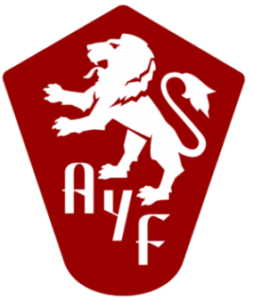AYF Lecture Highlights The Long Struggle for Workers’ Rights

Dr. Ara Khanjian discusses the history of the American labor movement as part of the Crescenta Valley "Zartonk" AYF's "Blueprint for Progress" educational series. Photo by Vache Thomassian.
The eight-hour day, sick leave, paid vacation, maternity leave, elimination of child labor, overtime pay, minimum wage laws, and even the weekend—these are just a few of the many benefits that society enjoys today thanks to the struggle of workers and the untold sacrifices of the American labor movement.
In order to shed light on the history and goals of this important movement, the Crescenta Valley “Zartonk” chapter of the Armenian Youth Federation hosted a community lecture this past Sunday featuring Dr. Ara Khanjian, Professor of Economics at Ventura College. This discussion centered on the history of organized labor and was the first installment in the chapter’s “Blueprint for Progress” educational series, an ongoing set of community lectures which will highlight themes and issues stemming from a progressive agenda.
“Dr. Khanjian really exposed us all to a new issue, and his presentation explored so many different facets of organized labor,” said Aris Hovasapian, Chair of the AYF “Zartonk” Chapter. “I have no doubt that everyone that was present learned something new about an issue that is at the forefront of American politics.”
The talk began with a review of some of the basic reasons behind why workers organize. Dr. Khanjian noted how the essential interest of employers is in maximizing their profit while employees, on the other hand, seek to improve their wages and working conditions. Given their relative powerlessness in comparison with those who hold the means to employ them, workers soon realize the importance of coming together and standing up for their rights through collective action. They form unions to leverage their demands and defend their interests on a more equal footing with those who control their workplace.
Given this empowering effect that organizing has on the working masses, it is no surprise that employers tend to be naturally antagonistic towards workers unionizing. Khanjian explained how unions are seen as a threat to profit and are often fought tooth and nail by employers. The cases of McDonald’s and Wal-Mart eliminating entire locations and departments simply due to unionizing efforts were presented as illustrations of this often extreme hostility by employers against any attempts by their workers to organize.

AYF members listen attentively as Dr. Ara Khanjian goes over the history and dynamics of union organizing. Photo by Vache Thomassian.
Indeed, this hostility has combined with a legacy of political persecution of socialists and labor activists in this country—as occurred during the infamous “Red Scare” of the 1950s—resulting in one of the lowest rates of workplace unionization in the entire industrial world.
“It’s hard to ignore the alarming fact that only about 13% of American laborers are a part of organized unions,” said Sanan Shirinian, a member of the “Zartonk” AYF who was in attendance for the lecture. “This reality exemplifies the unjust distribution of power in our workforce.”
As Khanjian pointed out, this rate is especially abysmal when compared to countries in Europe, where unionization sometimes reaches as high 70 to 80 percent of the workforce. Such differences are part of the reason why people in the US work longer hours than most others in the industrial world, yet enjoy only a fraction of the benefits and have seen their real wages stagnate over the last 3 decades.
However, despite this comparative weakness of the American labor movement today, workers in this country have long been at the forefront of a host of important progressive achievements in areas as diverse as workers’ rights, civil liberties, consumer protection, and civil rights. In fact, the well-known International Worker’s Day, celebrated annually on May 1st, originally developed as an international commemoration of the Chicago Haymarket Massacre of 1886, when American workers were gunned down by police during a strike for the eight-hour day.
Being presented such rarely-known facts by Dr. Khanjian was one of the most rewarding aspects of the evening for “Zartonk” AYF member Sanan Haroun. “Using real-life examples, such as the Haymarket Tragedy or the Triangle Shirtwaist Factory fire, within his presentation was a great method of connecting with the audience,” said Haroun. “It was the first time I was exposed to these issues and I find it crucial for everyone to be aware of such matters. They directly or indirectly affect everyone, no matter what career field they are in.”

Massachusetts militiamen with fixed bayonets surround a parade of peaceful strikers. The Lawrence textile strike was a strike of immigrant workers in Lawrence, Massachusetts in 1912 led by the Industrial Workers of the World. Source: http://womhist.bingh
The presentation, throughout, also laid focus on one of the universal tenets of the labor movement: solidarity. Unions show us that by coming together with people of common interests, pooling resources, and leveraging each other’s success, you can do things otherwise impossible and go a long way in making a difference for your community. This basic point was summed up by the following African proverb read to the audience by Dr. Khanjian: “If you want to go fast, then go alone. If you want to go far, then go together.”
During the question and answer period, these issues were further expanded upon through a lively back and forth covering such topics as labor standards in Armenia, the effect unions have on international competitiveness and the stance of the ARF on organized labor in general. These discussions carried on even past the question and answer session, as AYF members and those in attendance talked about what was presented over light snacks and refreshments.
Subsequent lectures in the Crescenta Valley “Zartonk” Chapter’s “Blueprint for Progress” educational series are scheduled for June 28, July 26 and August 23. The topics to be presented include the civil rights movement, environmental sustainability, and healthcare. For more information, contact AYFZartonk@gmail.com.















